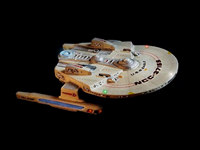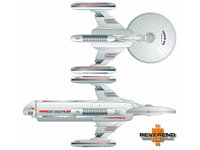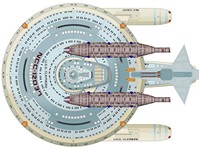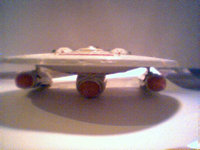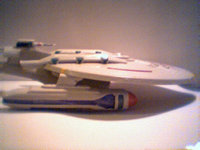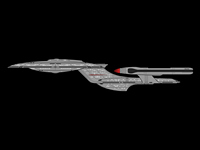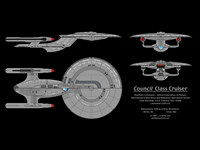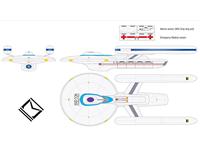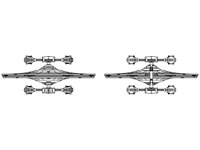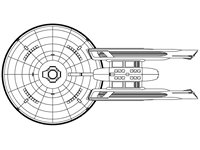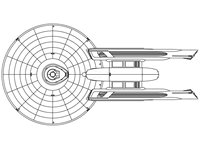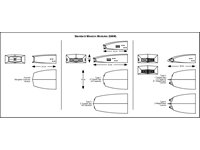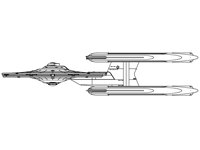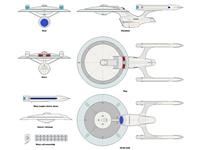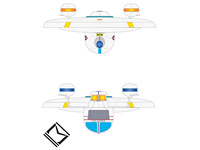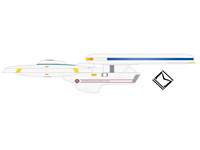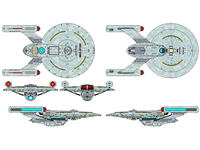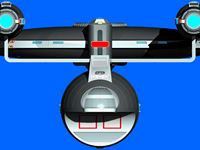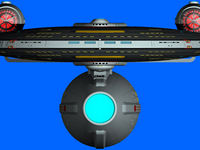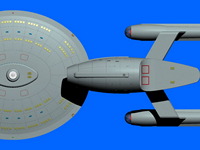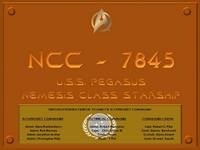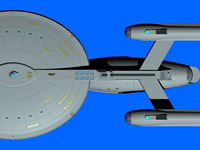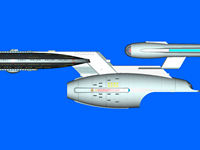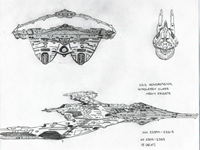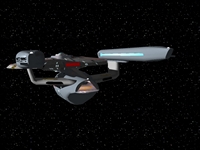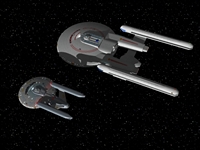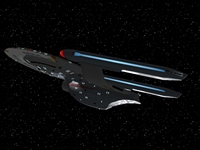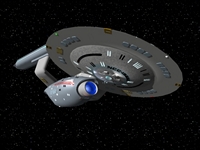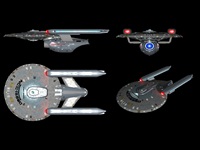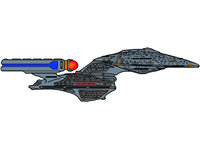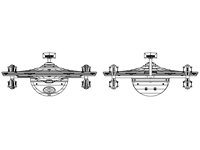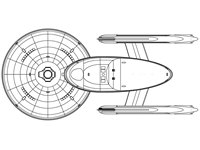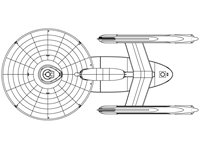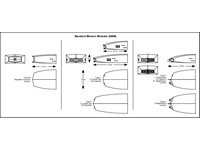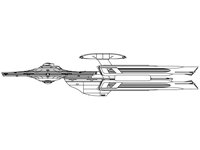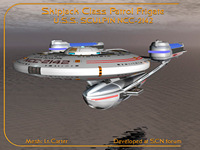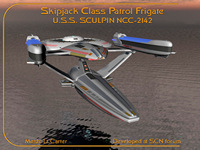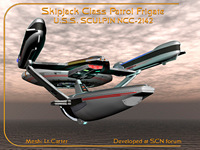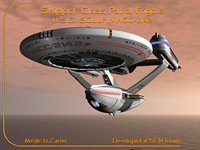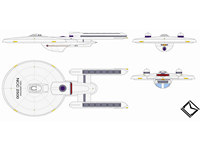Early 24th Century
History, 21st Century, 22nd Century, Early 23rd Century, Late 23rd Century, Early 24th Century, DY Starship Family
America Class
Design by Jason Abbadon
Type: Support vessel
Length: 240m
Width: 188m
Crew: 40 ( 3 command officers, 100 passengers)
Engine Data: 2 warp nacelles, 1 impulse engine system, one warp core
Shields and defensive systems: seven Type-VI phaser arrays covering all arcs, standard shields
Embarked craft: four Type-7, four Type-15 shuttles
Number constructed: eighty-seven total with sixty in active service and five in reserve status, seven destroyed and six decommissioned
The USS Eagle is an America-class variant of the Miranda class and is a support vessel for Federation colonies. The torpedo systems of the Miranda have been removed and their EPS systems are now used to power added labs and sensor equipment. Part planetary surveyor, part science platform and part patrol and resupply ship, the America class is found in colonized systems through the Federation frontier and are often the lifeline of supplies and equipment for newly established colonies.
Bristol Class
Design by Jason, ASDB Member
Type: Cargo ship
Length: 264.2m
Beam: 181.8m
Height: 181.8m
The Bristol Class Starship has been Starfleet's primary container carrier for several decades. Less a successor to the venerable Ptolemy Class than a next generation of design - Ptolemys were fine for their day, but with an increase of traffic amid the continually burgeoning Federation, a much more versatile ship was required - one which could also haul more containers at once.
Bristols are capable of carrying numerous types of containers (FJs, SCaTs, and Tridents, etc.), one feature which made them clearly rise above the competition in the years following the retirement of Ptolemy. Another system, the impulse rails, was one that Starfleet had been experimenting with on and off for nearly half a century. These units are able to vary their positions on the pylons (collectively known as "impulse wings"), thereby allowing for unusual payloads, specifically asymmetrical weight distribution. Several starships, having each lost a nacelle, have been towed out of hazardous areas, simply by adjusting the impulse engines' positions.
Though heavily shielded, and able to withstand several direct hits, Bristols are obviously not intended for combat. Defensive phasers are standard, while a handful were recently refit to include photon torpedo launchers and an upgrade to type VIII arrays. Several dozen Bristols served as mobile hospitals during the Dominion War; as with in previous conflicts, they were simply equipped with hospital and supply containers.
The quad-nacelle approach also provides heavy redundancy - one advantage being sustained periods of warp flight, quite necessary for the distances these ships must traverse to deliver their goods. It has also been proven possible to enter warp with only three nacelles, should one happen to be destroyed, damaged, or jettisoned - the impulse engines merely alter their configuration to restore a balance of thrust.
An additional option is the end pod, which magnetically attaches itself to the aftmost container. It holds an auxiliary 3-deck-high bay, storing mostly workbees for loading / unloading. Also included are options for additional quarters, recreational facilities, sensor suites, etc... It is joined to the main hull across the container's surface by three telescoping gangways - one on top, and one on either side. The main length of gangway is stored in the main hull.
The main hull's shuttlebays are located ventrally, as a split hangar to allow the impulse system to operate normally through the ship's centerline, vertically. There is a cross-over in the fore area, to allow greater mobility between sides. Extendable decks permit an increase in "parking space" in high traffic situations, as well as more room for emergency landings.
The SCaT containers (Starfleet Container Transport), were developed in the late 23rd century as an easier-to-manage option compared to the old-style 235m FJ containers, in use for nearly a century prior to that point. Some of the old ones remain in service, especially in civilian fleets, but the newer SCaT types have built-in shield grids, the better to operate independently. They also are only 156m in overall length, and are easier to manage in close quarters.
This is a previous design of the Deneva class being developed at the ASDB.
Claymore Class
Design by Alex
Type: Destroyer
In service: since 2332
Length: 413m (total)
Width: 320 m (saucer)
Height: 103m (total)
Decks: 31
Speed: Warp 6 (cruise), Warp 8.7 (max.)
Mass: 3,060,000t
Crew complement: 45 officers, 290 crew
The ship is conceived as a step between the Soyuz and Ambassador classes.
Council Class
Design by Jeff Robb
Type: Cruiser
First commissioned: 2329
Length: 529m
Width: 278m
Height: 94m
Decks: 26
Displacement: 2284000t
Complement: 197 officers + 485 crew
Speed: Warp 7 (cruise), Warp 9 (max.), Warp 9.2 (max. emergency)
Armament: 10 Type-IX phaser emitters; 6 standard photon torpedo tubes
Defense: Standard elliptical shields
Embarked craft: Typically 7 workbees, 7 shuttlepods, and 10 shuttles
In the tradition of the Constitution and Excelsior classes of Starfleet's first-line heavy cruisers, the Council class brought greater levels of operational capabilities to the fleet. They were designed and built about five years after the introduction of the Ambassador class, and were commissioned in order to compensate for some of that class's initial shortcomings. The fundamental features and components built into every cruiser of the Council class typically provided greater power and flexibility for their crews, in missions ranging from galactic exploration to diplomatic functions to all-out combat. Sensible exterior and interior designs, along with the advanced systems within, helped to earn this class of eighteen another exemplary service record for Starfleet. None have been lost or destroyed in combat as of Stardate 48980, but one -- the U.S.S. Zeitraum -- was slowly disintegrated by the effects of a previously unknown cosmic phenomenon; all but two of the crew were rescued, however. Another Council, the U.S.S. Tora Gana, was disassembled down to its sub-assemblies and then reassembled during a fleet-wide experiment intended to examine and improve starship reconstruction techniques. Originally, the Council class was intended to replace the entire Excelsior line, but due to the popularity of the older ships, the Councils have supplanted only a few of their predecessors while supplementing the rest. The class ship was named in honor of the Federation Council itself, and some others in this class are likewise named after historically notable councils or conferences.
Due to their similarities, this class has also been continuously compared to the Ambassadors. Each new heavy cruiser line brought different component innovations to the fleet; interestingly, the Ambassadors placed vertical viewports and numerous small lifepod hatches upon a bulky Constitution-style hull, while the Councils kept horizontal viewports and internal lifeboats within a more streamlined hull. The Ambassador's impulse engine was placed in the ship's midsection and necessitated the integration of a driver coil assembly, whereas the Council's version did not, and remained in the traditional location for use by the saucer section after an emergency separation. Yet perhaps most interestingly, new experimental approaches were taken with each cruiser's phaser banks: the Ambassador featured phaser array tracks placed to cover forward, port, starboard, and aft directions, while the Council placed twenty enlarged ball-turret emitters within coves upon two large rotating rings. Sections of the rings were interchangeable, allowing various arrangements of emitters, although this involved extra-vehicular activity. The standard arrangement favored a dense forward concentration, and a Council could fire any eight of the emitters at full power. The rings rotated quickly for their size, enabled instant multiple phaser strikes in nearly any direction, and could fully maintain their fire while rotating. So equipped, a Council's phaser firepower was superior to both Excelsior's and Ambassador's, and served the class well during the Cardassian hostilities. Despite these advantages, the additional power requirement to move the rings led to occasional electromagnetic glitches with the system, so Starfleet eventually opted to refine the phaser track approach, which culminated with the large elliptical phaser tracks of the Galaxy / Nebula starships. The photon torpedo tubes of a Council were more conventional, though, and were similar to an Excelsior's, aside from two additional forward tubes that normally served as probe launchers. Whereas a Council was also typically faster at both sublight and warp speed, and were more easily built and maintained, the Ambassador line ultimately enjoyed greater success in scientific and diplomatic missions. Occasionally, ships of each class served together on the same missions, and always subordinated any "friendly rivalry". Even though it never disrupted routine fleet operations, this rivalry did come to a head when the fleet's most famous starship name became available.
Both of the competing shipbuilding firms behind the Council and Ambassador lines had anticipated the possibility of having one of their ships christened as the next starship Enterprise; so, when the opportunity arose, both were quick to advocate their particular class, prompting Starfleet Command to consider each. Proponents of the Council class in Starfleet also sought to end the alphabetizing of the registry number NCC-1701, offering instead the number 41701, which was already scheduled to be part of the class in any case. It was apt, they argued, to include the original number (1701) and the number 4, which of course would represent the fourth starship Enterprise. This, along with the Council's particular style and substance, impressed the deciding board enough to grant the class the initial recommendation, along with the new number; however, the final decision reversed the Council's fortune and officially reserved the name of Enterprise to an Ambassador-class vessel then beginning construction. The Council-class cruiser that was to be named Enterprise was renamed as the Elesca, number 41701, while the alphabetized number of 1701-C was assigned to the fourth starship Enterprise after all. That final decision did not demoralize the Council class's proponents and crews for long; nor was it the last time that the class had something to do with a starship named Enterprise.
During the early stages of the Galaxy Class Starship Development Project, several operational ship classes were examined by project engineers in search of top-rated components and inventive integrations. Since this project was intended to culminate in a class of the largest and most sophisticated of Federation starships, the parameters were as extensive as the efforts spent to reach or exceed them. Of all the starship classes examined, though, it was the Council class that received the most attention from the project engineers. Its particular lines and features provided a remarkable basis that, when maximized, could well result in just the kind of explorer/heavy cruiser the Project was interested in creating. Many years later, after an exhaustive design and construction process, ships of the Galaxy class joined Starfleet; and among them was the fifth starship to bear the name of Enterprise. Intriguingly, reports continue to persist that a sculpted profile of the Council class was present in place of the Ambassador class on a wall of the Enterprise-D's top-deck conference room. If so, it was an unusual occurrence in that long rivalry between the two pre-Galaxy cruiser lines, and perhaps a small measure of compensation to those who felt cheated by the Enterprise-C decision many years ago. Even though the Enterprise-D recently fell to enemy fire, after only seven years of service, the performance of the ship itself was excellent up to that point. The Galaxy class, for the time being, still represents the pinnacle of explorer-ship development within the Federation, thanks in part to the inspiration of the Council class. As of Stardate 49001, Starfleet is currently reviewing upgrade plans for the remaining Councils as part of the effort to rebuild and reconfigure the fleet.
Designer's notes: This speculative design and the Ambassador Prototype described at Ex Astris Scientia both refer to the original design for the 1701-C. A detailed, color-blueprint cross section of the Council class (approx. 564k JPEG) is also available via email, as is a similar cross section of the Excelsior in its initial experimental (transwarp) configuration.
Firefly Class
Design by voron
Type: Light freighter
First commissioned: 2316
Length: 154m
Width: 55m
Decks: 7
Complement: 18 officers + 55 crew, evacuation limit: 500
Speed: Warp 7.5 (cruise), Warp 8.7 (max.), Warp 9 (max. emergency)
Armament: 6 Type-VI phasers in two twin mountings and 4 single mountings
Defense: Standard shields
Embarked craft: Three Class-2 personnel shuttles or a single Class-3 cargo shuttle
Originally commissioned in 2316, the Firefly class freighter has become a common sight on the colonial trades routes of the Federation and is known as one of the most reliable small-sized freighters ever. At the end of the 23rd Century, the Federation faced a turning point in its history. With the decades' long dispute with the Klingon Empire finally coming to a peaceful resolution and encounters with the Romulans enemy becoming increasingly sporadic. The new century would herald a new era of peace, expansion and colonisation. As they moved further out into the recently surveyed depths of the Alpha Quadrant, a new wave of colonists found themselves increasingly isolated and the Federation's supply and logistics agencies became overwhelmed and struggled to keep up with the burgeoning pace of colonial expansion. This was due in part to the neglected status of the freighter fleet, which at that time consisted mainly of antiquated Merchantmen, or old robotic drones.
It was in 2295, just a year after the First Khitomer Conference had changed the Federation's political and economical landscape. The Federation Council charged the Federation design companies with the development of a small to medium range cargo carrier that could make rapid cargo runs between a logistical centre and a sector-wide area of settlements and outposts. The design was to be robust and adaptable to a number of support service mission types, and a cargo shuttle facility sufficiently large for it to handle up to three Class-2 personnel shuttles or a single Class-3 cargo shuttle. The Firefly class freighter is 154 meters in length, has a beam of 55m. Normal cruising speed is Warp Factor 7.5 but the Firefly can achieve a maximum of Warp 8.7 for a period of up to 22 hours. Given ideal conditions, a emergency speed of Warp 9.00 is possible for up to three hours. Cargo is carried in large pods that are affixed to the lower aft engineering hull. There are three types of pod four Single cubes or double or one long pod. These can be modified for many purposes. The Star Fleet Marines had 12 converted to emergency actions ships with drops shps and a complement of of 120 Marines or a hospital pod designed for use in extreme emergencies.
A total of 300 of these vessels were constructed over a ten-year production run from 2316 to 2326, encompassing 17 shipyards across the Federation. Of these 300 only 23 have been lost and only 8 to hostile actions.
Fletcher Class
Design by Steve Justice
Type: Destroyer
First commissioned: 2312
Length: 273.5m
Width: 142.1m
Height: 59.6m
Decks: 12
Displacement: 500000t
Complement: 20 officers + 210 crew, evacuation limit: 390
Speed: Warp 7.0 (cruise), Warp 8.2 (max.), Warp 8.8 (max. emergency)
Sublight speed: 0.75c (max.)
Armament: RIM-16C twin mount phasers (8), Mk 70 torpedo tubes (4)
Defense: EMD-6 primary deflector shield, CSCS-13E countermeasures system
Embarked craft: 2
As Star Fleet entered the 24th century, destroyer development was at it lowest level in the history of the Federation. Improving relations with the Klingon Empire and the abundance of "Constitution style" destroyers, frigates, and other escorts combined to place new destroyer development at a low priority. Beginning in 2290, destroyer development was limited to several twin-nacelle fast destroyer prototypes with an average production of less than one ship per year.
However, by 2310 many older destroyers were reaching their design lives. The majority of the single nacelle destroyers were thoroughly worn-out as they were originally launched prior to 2250 and were later modified with linear warp drives in the 2270's. In spite of expanded SLEP, the total number of available escorts began to rapidly decrease until the total number of available destroyers numbered less than 50 in 2310. In response, Star Fleet transferred frigates into the traditional destroyer roles of fleet escort and border patrol, which reduced the number of ships available for exploration.
In 2311, the Tomed incident between the Romulan Empire and the Federation highlighted the need for a strong destroyer force as a border 'trip-wire'. The forward Romulan attack force of destroyers were able to use their superior acceleration, maneuverability and numbers to quickly neutralize the frigate border patrol force to allow a rapid Romulan thrust into Federation space. A strong destroyer force, while not able to defeat the stronger attack force, could have slowed the attackers enough to allow the Federation Rapid Response Force to intercept the Romulan attack force short of Federation space lanes. The lack of destroyers also caused some difficulties for the Federation task force in the final battle.
After the Tomed incident, Star Fleet set out on a 'crash' program to add 50 new destroyers and heavy destroyers to the fleet in a ten year period. In light of limited credits, and to reduce development time, the new designs developed in the program used a maximum of existing, in-production, and replacement starship components and systems.
New destroyer, the Fletcher class, and heavy destroyer, the Sheffield class, designs were developed to augment the Excelsior and Constellation class cruisers then in production. The designs utilized "Constitution style" main hull, which was still in production, combined with refurbished warp nacelles and subsystems salvaged from replacement stocks and retired cruisers, frigates, and destroyers. The Fletchers and Sheffields represented a rebirth in destroyer development after a lull of over 20 years.
Fletcher class overview
The lead ship of the class, the USS Fletcher, was designed by the Star Fleet Division - Office of Naval Construction and constructed in 2312 at the Star Fleet Division Singapore Yards. Production contracts for subsequent ships were evenly split between Star Fleet Division Singapore Yards and Avondale Group Saturn Yards. Production was initially planned for 25 units, but production was cancelled after only 14 units to allow Starfleet to move forward with new technology designs using Ambassador class technology.
In service, the Fletcher class filled a gap In the Star Fleet destroyer force until the fielding of new designs. While not outstanding in any single respect, the Fletcher class demonstrated good all-around capabilities which well suited them to extended border patrol duties. Their toughness was demonstrated when two Fletchers intercepted and defeated a Cardassian battle cruiser attacking Federation border settlements. All Fletchers were retied by 2340.
Design
The requirements for the Fletcher design included a design range and speed to match Excelsior and Constellation cruisers, and improved phaser and torpedo firepower. The requirements for the warp power, fuel storage, and torpedo capability forced the designers to adopt several features not previously seen on destroyer class ships.
In order to meet the power and warp speed requirements, a cruiser type matter/antimatter reaction assembly (M/ARA) was required along with warp engines capable of generating a 70% greater warp field density than in previous destroyers. Since no production warp engine existed to meet the requirement using two nacelles, and funding was not available for development of a new warp engine, the designers adopted the four nacelle configuration first used in the Constellation class. The engine pairs were located aft of the main hull on dorsal and ventral support hulls. The M/ARA was contained in the support hull along the Z-axis of the ship
Previous destroyer designs accommodated the matter/antimatter storage in the ventral support hull or the aft portion of the main hull (saucer). The increased fuel storage of the Fletcher required a different approach; separate storage pods carried external to the main hull. The pods, one each for matter and antimatter, are located between the warp nacelle pairs to minimize structural weight and warp field interference. This arrangement had the added advantage of placing the matter and antimatter containment in close proximity to the appropriate injectors at the ends of the M/ARA.
The matter/antimatter storage pods also served as the supports for torpedo/phaser/navigation deflector modules. These modules could be replaced at any forward depot for maintenance, damage repair, or to match ship weapon/sensor capabilities to upcoming mission requirements.
The Fletchers utilized a "Constitution style" main hull design taken from the Belknap strike cruiser class with replaceable computer core and bridge modules. A new destroyer class bridge module was developed for the Fletchers to fully interface with the Excelsior and Constellation class ships.
Engineering systems
The Fletcher design utilized LN-64 series linear warp engines in a four nacelle configuration pioneered in the Constellation class exploratory cruiser. The ventral and dorsal engine pairs were partially cross-linked to dampen warp harmonic effects between each engine pair. The maximum warp field output was limited by M/ARC input to 80% of the Constellation class.
Impulse engines were standard Belknap strike cruiser units to compensate for the increased ship mass and to provide superlative sub-light acceleration required in a destroyer. The expanded energy requirements of the propulsion and weapon systems were supplied by an America class heavy cruiser derived M/ARC. Life support and other auxiliary systems are derived from earlier Belknap systems.
Command, communication & control systems
Command, Communication and Control (C3) systems on the Fletchers were a mix of explorer and battle cruiser systems to meet long range patrol and tactical requirements. The design team utilized modified Constellation and Excelsior class to meet the severe development time and cost requirements for the new destroyer design with those systems coordinated by a Daystrom library computer system specifically modified for the destroyer mission.
Weapon systems
The Fletchers were the first class to use the Standard Mission Module (SMM) in place of fixed torpedo tubes and phaser cannon. The original design featured fore and aft torpedo modules on the dorsal strut and one aft torpedo module on the ventral strut. Later production ships employed a combination torpedo and phaser cannon module to provide a more versatile armament. Operational experience revealed that the proximity to the warp nacelles adversely effected phaser aiming due to strong warp field/phaser interaction. For this reason, the phaser cannons were useful only during sublight engagements.
In addition to being the first class to use SMMs, the Fletchers, along with the Sheffields, were the last major combatants to user phaser turrets as main armament. The phaser turrets and shielding systems represented a version improvement over their Excelsior class predecessors.
Due to the high probability of engagement with multiple opponents, the shielding capabilities of the Fletchers were designed to exceed that of other contemporary class one ships. Total shield energy rejection capability exceeded the Excelsior class by 15%.
Icarus Class (2)
Design by Belz...
Name: USS Icarus NCC-2300
Type: Explorer
First commissioned: 2302
Length: 310m
Width: 151m
Height: 68m
Decks: 19
Complement: 80 officers + 395 crew
Speed: Warp 7 (cruise), Warp 8.4 (max.), Warp 8.7 (max. emergency)
Sublight speed: 0.65c (max.)
Armament: 5 phaser arrays, 3 photon torpedo launchers
Embarked craft: 8 shuttlecraft, 4 shuttlepods
History
During the test flights of the Excelsior in 2284-86, Starfleet was considering retiring their 40 year-old design, the Constitution-class. Already refitted several times, the veteran design was no longer suited for long-range exploration missions. Although the Excelsior's new warp engine was meant to make travel times shorter, the increasing volume of the Federation and the sheer bulk of the new transwarp engines meant that the Constitution design was no longer viable. Because the Excelsior was not originally scheduled for mass production, a new design, based on the "Great Experiment", was ordered. Initial plans for the new ship called for a 420m spaceframe that would carry heavier tactical systems. Before the Khitomer conference, Starfleet was concerned about renewed Klingon activity near the Organian treaty border, especially following the Genesis incident. However, economic considerations made production of the design difficult, and it never developed beyond the drawing board.
Starfleet instead asked for a starship closer in size to the venerable Constitution, but administrative lobbying delayed the process for several years. Following the explosion of Praxis, the Klingons became less of a threat, but tensions rose rapidly with the Romulans who were concerned about a possible alliance between their two rivals. Although this would not materialise until much later, the Empire would not be a major foe until 2337. Still, regular raids by the Orion and Gorn, combined with the Romulan threat, finally convinced Starfleet that it was in dire need of new designs, and though the Excelsior and the Enterprise (NCC-1701-B) were now in active service, it would take the inclusion of the mineral-rich Betazed and Bolarus into the federation to make possible the mass production of the huge vessels of that class.
In order to bring new blood into the fleets as early as possible, Starfleet decided to attempt one, final upgrade to the Constitution-class. Although the class was scheduled for complete deactivation by 2305, this was deemed an economic solution at first. It soon became clear, however, that the new technologies and techniques included in the proposed plans would require a completely new ship. Remembering well the lessons of the 2270 upgrade, the Federation opted for a new designation instead of an overhaul on existing ships, and called for the construction of a prototype for the new class, Icarus.
Completed in 2302, the Icarus was a satisfactory design, though Starfleet engineers had hoped more from the advanced engines based on the Excelsior trials. When the ship was cleared for production, so many suggestions, changes and adjustments were made that a whole new ship was eventually drawn, and what would come out of the assembly lines in 2308 would become one of the United Federation of Planet's most successful starship class: the Ambassador.
Only one Icarus was ever built, but that prototype served the Starfleet for 31 years, and the ship and its crew were decorated several times. The vessel's unique, beige paint scheme was only used for a few years, however, on other contemporary designs.
Technology and abilities
The Icarus incorporates several innovations that would later become standard during the 24th century. First, the ship was the first to include a modular bridge system, allowing the ship's interface and command stations to be upgraded in minutes. The Icarus' large impulse engines allow unprecedented sublight speeds, though the introduction of the Ambassador's revolutionary fusion reactors, allowing for much smaller engines for greater performances, would soon overshadow this accomplishment. Its warp engines, the last of their kind, would carry the Icarus faster than any other before, though by today's standard they were particularly harmful to the subspace fabric. Also notable was the presence of two separate engineering rooms, one for the impulse control and one for the warp drive, something that had not been seen since the first few ships of the Constitution class.
The most remarkable addition to the ship is its five phaser arrays. Indeed, the Icarus prototype was the very first design to be fitted with phaser "strips". Unfortunately, the size of the strips created phase-distribution problems that would only be solved with much more recent designs such as the Nebula. The Ambassador-class mounted truncated strips, and the usefulness of that compromise was debatable. The Icarus' shield grid was also improved over previous designs, providing increased distance between the shield itself and the hull. The starship also included improved RCS thrusters and transporter emitters.
Although the Icarus herself was never considered a great achievement, the technologies and techniques incorporated into the vessel proved instrumental to the development of the current starships of the Federation, and is listed as the first important design of the 24th century.
Leopard Class
Design by Voron
Type: General purpose frigate/science ship
First commissioned: 2315
Length: 230m
Width: 120m
Height: 32m
Decks: 7
Complement: 10 officers + 100 crew, evacuation limit: 150
Speed: Warp 8.7 (cruise), Warp 8.9 (max.), Warp 9.1 (max. emergency)
Armament: 8 Type-VI Phasers (twin banks), 2 photon torpedo tubes (2 fore)
Defense: Standard shields
Embarked craft: 4 type 4 mid-range shuttles
The Leopard class was designed to fill a fleet request for a sub 300-metre science ship with the abilities of an Excelsior class and the Ambassador class with a full exploration capabilities, offensive and defensive of the larger ships. The ship was required to be very cheap to maintain, compared to the Excelsior class. The design borrows heavily from its bigger brother the Excelsior class and from the Ambassador class. Designed for mid to long range exploration missions of no more than 2 years the Leopard class included the latest generation of sensors based on the Excelsior's class standard sensors but upgraded to a much higher standard these sensors where linked to the computer core and science facilities. This allows the Leopard class to perform the job of Excelsior or Miranda for the expense of deploying a Frigate. The internal design of the ship allows a certain flexibility all the science labs are designed as a basic large rooms with consoles arranged around it. The centre of the room in its basic form when launched is empty but below the floor panels are hard points to connect other consoles or other equipment that's needed, any arrangement can be made with them in a short time.
The Leopard class can be used for many different purpose. It is designed to be reconfigured with ease though it does require the use of a drydock for a few days some of what it can be used for are
- Planetary survey (life sci. and geology labs)
- Star mapping and long range sensors (w/ extra memory for the computer and an astrophysics lab)
- Stealth commando transport (a small command centre/With extra bunk space in the cargo bays for troops)
- medical evacuation (a large triage centre in the cargo bays)
All these different version and more can be used the main problem being that what you add you also lose out on something. For example the cargo bays in both bunk space and medical evacuation mean that its mission length will be decreased significantly.
The Leopard class's main drive systems are two of the most powerful that could be fitted. The impulse system is a large unit designed to be efficient and easily repaired in the field when the ship is well away from spacedock. The warp engines are also of a new design. They where construed using new materials and in accordance with new subspace theory and warp dynamics. This allowed the ships to have a shorter nacelle than other classes at this time without losing any performance. The warp core is a new design that though compacted to 7 decks it gives the output of the original Excelsior's core with 8% increases in efficiency and a 20%
increase in service life compared to the Excelsior. After the 7th ship was launched a redesign was built in to the 8th ship this meant the redesign of the nacelles struts as a result of the failure of the pylons on the 2nd starship during high stress activities during a classified mission. The pylons where redesigned the a stronger L design like the NX-2000 and the nacelles themselves where replaced with the latest design allowing a longer service life before a major refit and overhaul.
The Leopard's weapons systems consist of 8 Type VI in twin mounts and 2 forward torpedo tubes. The phasers are of the Type VI Block 10; these versions have a greater power output compared to the original block 0 and block 1 version. The main reason for the installation of these units is that though they are powerful weapons they are highly efficient in terms of power consumption and accuracy. The torpedo tubes are of the standard single fire version with both fore and aft areas covered 60 torpedoes are carried with space for 30 probes. The crew of 110 enjoys a high standard of luxury compared to Constitution and Oberth crews of a few years previous with only junior crew having to share with a bunkmate and a large recreation deck provided to elevate the boredom of shipboard life. Most of the crew enjoys use of either a shared lounge on there quarters, with senior officers having use of a lounge and the captain and XO having a small dinning area for dignitaries. The Leopard class was involved with many first contacts and scientific firsts. The flexibility of the design meant they where used as general survey ships of inner worlds of the federation and as first survey ships of newly discovered worlds. The Leopard class served the Federation well till 2360 when a new generation of ships replaced her. Her production run lasted from 2315 till 2319 and 55 ships where constructed.
With thanks to SCN for insight on this.
Merced Class
Design by Ed
No specs available
This is an alternative design for the Merced class being developed at the ASDB.
Nemesis Class
Design by Capt. Robert C Pike
Type: Heavy cruiser
First commissioned: 2340
Length: 545m
Height: 101m
Decks: 65
Displacement: 1980000t
Complement: 30 officers + 620 crew
Speed: Warp 8 (cruise), Warp 9 (max.), Warp 9 (max. emergency)
Armament: Phaser Type II, photon torpedoes Mark VI
Defense: Shields
The Nemesis class is a heavy destroyer and research vessel for the protection in the Federation area is planned.
Special thanks to Robert Heckadon for his fabulous work.
Nikolayev Class
Design by James Donovan
Type: Patrol ship
In service: 2305-2355
Length: 360m
Beam: 90m
Decks: 18
Speed: Warp 6 (cruise), Warp 8 (max.), Warp 9 (for 1 hour)
Crew complement: 60 officers, 160 crew
No description
Orion Class
Design by Nixon's Head
Type: Surveyor
First commissioned: 2331
Length: 190m
Width: 125m
Height: 36m
Decks: 12
Complement: 20 officers + 90 crew
Speed: Warp 5.0 (cruise), Warp 8.2 (max.), Warp 8.6 (max. emergency)
Armament: 5x phaser strips, 1x photon torpedo launcher
The Orion-class starships were introduced in the early 2330s to meet the need for an updated long-range surveyor. This mission had previously been carried out by the Vega-, Soyuz- and then Constellation-classes, but by the mid-2320s it was felt that starship technology had advanced sufficiently that a new class was justified. Distinct from (and perhaps less glamorous than) the detailed scientific investigation or long-range exploration missions undertaken by ships of the Oberth, Excelsior and Ambassador classes, the primary task of the Orion was to provide detailed navigational charts of Federation space in support of interplanetary commerce, the safety of civilian traffic, and defence planning. Survey missions supported Federation commerce by providing the information needed by ship's masters in plotting the fastest courses, whilst avoiding potentially hazardous natural phenomena. They also gave Starfleet valuable data on spatial terrain for use in planning peacekeeping or humanitarian operations, identifying blind-spots or favourable fleet movement routes along the borders with potentially hostile forces.
From its formal start in 2321, the Orion-class starship development project lasted for ten years, with the lead ship launching in mid-2331. The design was to incorporate several recent technological advances, including an isolinear-based computer core and multiplex pattern buffers to improve transporter safety.
The class also included some of the first phaser-strips, based on units developed under the Ambassador-class project. The Orion mounted three phaser arrays on the primary hull, with two more placed on the nacelle support struts covering the aft firing arc. A single forward-facing torpedo tube was mounted at on the secondary hull, giving the ship a modest defensive capability in line with its expected duties.
The warp drive system of the Orion was to prove controversial in some circles. In an effort to improve engine cruising efficiency and endurance at low to mid-warp factors, the leading warp field lobe was pushed forward relative to the hull to obtain a more even balance of mass between the forward and aft lobes. Part of this concept involved placing the warp nacelles further forward and much closer to the primary hull than had been the case on most previous starship designs with similar power levels, giving rise to fears in the general press and Starfleet Command that crewmembers would be exposed to dangerous levels of subspace radiation. ASDB engineers insisted that subspace field differential levels, although elevated, would remain within safe limits at all speeds, but concern amongst the public and some Starfleet personnel remained. To placate this, additional duranium shielding was added to key areas of the aft primary hull, and crew quarters were located to the fore and ventral, away from the nacelles. This succeeded in allaying the fears of the crews asked to serve on Orion-class ships, and eventual operational experience vindicated the views of the designers. No adverse effects were observed from the placement of the nacelles, and this eased the way for similar designs to be employed on the later New Orleans and Saber-classes. Much of the additional shielding was removed as unnecessary in a series of refits starting with USS Peary in 2340, which also saw the replacement of the ships' original lifeboats with the new standardised ASRVs.
Ships of the Orion-class have served with distinction for almost sixty years. A total of 55 ships were constructed between 2331 and 2348, primarily at the Cochrane Fleet Yards of Alpha Centauri and the Deneb IV Starship Integration Facility. Notable achievements include the first charting of a safe passage through the Briar Patch by USS Clemenceau in 2344; USS Galileo's characterisation of the movement of protomatter concentrations in the Mutara Sector in 2353; and USS Sirius' detailed mapping of new routes between Earth and Bajor that resulted in significant reductions in round-trip times in the early 2370s. Perhaps their greatest success was the instrumental role Orion-class ships played in finding new, low-impact routes for civilian traffic following the discovery of the damage caused to subspace by warp travel in 2370. This stalwart work in identifying the areas of subspace at the highest risk of degradation enabled the vital new environmental protection regulations to be imposed with only a minor impact on interstellar trade. The Orion-class USS Paxton also served as a testbed vessel for the warp drive upgrades which eventually allowed older ships to be refitted to completely eliminate subspace degradation effects, a role with some irony given the earlier concerns over the safety Orion's own warp drive.
In addition to their valuable peacetime service, ships of the Orion-class also supported Starfleet in front-line roles in a number of conflicts. This included hunting for enemy supply dumps in the Cardassian Wars of 2348-2366; clearing gravitic mines from commercial spacelanes during the Talarian Conflict; and most recently performing daring advanced-scouting missions that were instrumental in characterising Dominion defences during the 2375 invasion of the Cardassian Union.
With the introduction the Intrepid-class, the Orion-class began a gradual phase-out from Starfleet duty starting in 2379. Starfleet expects to have removed the last Orion-class vessel from its lists by 2390, with most being transferred to the local security fleets of various Federation and allied governments.
Pre-Galaxy Class
Design by T. Junk
No specs available
This is an early project stage of the Galaxy class.
Sheffield Class
Design by Steve Justice
Type: Heavy Destroyer
First commissioned: 2315
Length: 304.3m
Width: 142.1m
Height: 66.3m
Decks: 16
Displacement: 650000t
Complement: 25 officers + 225 crew, evacuation limit: 510
Speed: Warp 7.2 (cruise), Warp 8.4 (max.), Warp 9.0 (max. emergency)
Sublight speed: 0.75c (max.)
Armament: RIM-16C twin mount phasers (9), 'Rapier' phaser cannons (4)
Defense: EMD-6 primary deflector shield, CSCS-13E countermeasures system
Embarked craft: 2
History
As Star Fleet entered the 24th century, destroyer development was at it lowest level in the history of the Federation. Improving relations with the Klingon Empire and the abundance of "Constitution style" destroyers, frigates, and other escorts combined to place new destroyer development at a low priority. Beginning in 2290, destroyer development was limited to several twin-nacelle fast destroyer prototypes with an average production of less than one ship per year.
However, by 2310 many older destroyers were reaching their design lives. The majority of the single nacelle destroyers were thoroughly worn-out as they were originally launched prior to 2250 and were later modified with linear warp drives in the 2270's. In spite of expanded SLEP, the total number of available escorts began to rapidly decrease until the total number of available destroyers numbered less than 50 in 2310. In response, Star Fleet transferred frigates into the traditional destroyer roles of fleet escort and border patrol, which reduced the number of ships available for exploration.
In 2311, the Tomed incident between the Romulan Empire and the Federation highlighted the need for a strong destroyer force as a border 'trip-wire'. The forward Romulan attack force of destroyers were able to use their superior acceleration, maneuverability and numbers to quickly neutralize the frigate border patrol force to allow a rapid Romulan thrust into Federation space. A strong destroyer force, while not able to defeat the stronger attack force, could have slowed the attackers enough to allow the Federation Rapid Response Force to intercept the Romulan attack force short of Federation space lanes. The lack of destroyers also caused some difficulties for the Federation task force in the final battle.
After the Tomed incident, Star Fleet set out on a 'crash' program to add 50 new destroyers and heavy destroyers to the fleet in a ten year period. In light of limited credits, and to reduce development time, the new designs developed in the program used a maximum of existing, in-production, and replacement starship components and systems.
New destroyer, the Fletcher class, and heavy destroyer, the Sheffield class, designs were developed to augment the Excelsior and Constellation class cruisers then in production. The designs utilized "Constitution style" main hull, which was still in production, combined with refurbished warp nacelles and subsystems salvaged from replacement stocks and retired cruisers, frigates, and destroyers. The Fletchers and Sheffields represented a rebirth in destroyer development after a lull of over 20 years.
Sheffield class overview
The lead ship of the class, the USS Sheffield, was designed by the Star Fleet Division - Office of Naval Construction and constructed in 2315 at the Star Fleet Division Singapore Yards. Production contracts for subsequent ships were evenly split between Star Fleet Division Singapore Yards and Avondale Group Saturn Yards. Production was initially planned for 25 units, but production was cancelled after only 8 units to allow Starfleet to move forward with new technology designs using Ambassador class technology.
In service, the Sheffield class demonstrated good all-around capabilities and were excellent command and control units which served in many "hot spots" along the Federation borders. All Sheffield class ships were engaged in numerous combat situations over their 40 years of service with no losses. The last Sheffield class ship was reluctantly retired by Starfleet in 2359.
Design
The requirements for the Sheffield design included a design range and speed to match Excelsior and Constellation cruisers, improved phaser and torpedo firepower, and the ability to act as the flagship for a destroyer squadron. The requirements for the warp power, fuel storage, and torpedo capability along with command, communication & control systems forced the designers to adopt several features not previously seen on destroyer class ships.
In order to meet the power and warp speed requirements, a cruiser type matter/antimatter reaction assembly (M/ARA) was required along with warp engines capable of generating a 100% greater warp field density than in previous destroyers. Since no production warp engine existed to meet the requirement using two nacelles, and funding was not available for development of a new warp engine, the designers adopted the four nacelle configuration first used in the Constellation class. The engine pairs were located aft of the main hull on dorsal and ventral support hulls. The M/ARA was contained in the support hull along the Z-axis of the ship.
Previous destroyer designs accommodated the matter/antimatter storage in the ventral support hull or the aft portion of the main hull (saucer). The Sheffield became the first destroyer type to utilize a separate engineering hull. The large capacity engineering hull, along the general lines of the Excelsior, provided ample volume for all specified mission systems and increased fuel storage that provided the Sheffields with exceptional endurance.
The Sheffields utilized a "Constitution style" main hull design taken from the Belknap strike cruiser class with replaceable computer core and bridge modules. A new destroyer class bridge module was developed for the Sheffields to fully interface with the Excelsior and Constellation class ships
Engineering systems
The Sheffield design utilized LN-64 series linear warp engines in a four nacelle configuration pioneered in the Constellation class exploratory cruiser. The ventral and dorsal engine pairs were partially cross-linked to dampen warp harmonic effects between each engine pair. The ship also employed a Constellation class M/ARC to reach the maximum warp field output available from the four nacelle layout.
Impulse engines were standard Belknap strike cruiser units to compensate for the increased ship mass and to provide superlative sub-light acceleration required in a destroyer. Life support and other auxiliary systems are derived from earlier Belknap systems.
Command, communication & control systems
Command, Communication and Control (C3) systems on the Sheffields were a mix of explorer and battle cruiser systems to meet long range patrol and tactical requirements. The design team utilized modified Constellation and Excelsior class systems to meet the severe development time and cost requirements for the new destroyer design. However as compared to the contemporary Fletcher class, the Sheffield doubled the capacity and throughput of those systems to fit the command and control role of the heavy destroyer.
Weapon systems
The Sheffields had four torpedo tubes located in the engineering hull and nine RIM twin phaser turrets located strategically to provide a full field of fire. The Sheffields also employed a dorsal mounted strut with two Standard Mission Modules (SMM). The original design featured fore and aft torpedo modules on the dorsal strut. When operational experience revealed that phaser capability was more important than torpedo capability in close quarters combat; the SMMs were changed to twin megaphaser cannon type 4 modules which provided the Sheffields with unmatched phaser striking power.
Due to the high probability of engagement with multiple opponents, the shielding capabilities of the Sheffields were designed to exceed that of other contemporary class one ships. Total shield energy rejection capability exceeded the Excelsior class by 20%.
Skipjack Class
Design by Lt.Carter
Type: Patrol frigate
First commissioned: 2307
Length: 314m
Width: 178m
Height: 103m
Decks: 25
Complement: 10 officers + 140 crew, evacuation limit: 150
Speed: Warp 7.8 (cruise), Warp 8.5 (max.), Warp 9.1 (max. emergency)
Sublight speed: 0.99c (max.)
Armament: 10 standard phaser banks, 4 photon tubes (2 fore 2 aft)
Defense: standard shield grid
Embarked craft: 6 standard shuttlecraft, 2 aqua shuttles, 4 shuttle pods, 2 work bees.
By the 24th century Starfleet realized the need for a new vessel capable of filling the roll of both patrol ship and frigate. Looking at the Oberth class vessel, a sturdy design, engineers set about building a larger more capable vessel. The skipjack class was the result of 2 years of design and warp dynamic tests at the DSM test facility. Construction of the first vessel was finished in 2307 with 6 other ships proposed. The skipjack NCC-2141 currently patrols 3 star systems along the Romulan neutral zone with the recently built Sculpin NCC-2142, patrolling the Earth-Vulcan route. Both ships being equipped with heavy tractor emitters and a very early form of tachyon sensor palettes.
Inspiration: Beagle NGC-7293 (basic design concept) "abandoned", Dumont by Medjai = (bridge-other details), Oberth by David Carson, Excelsior by Bill George (sensors, warp drive), Ent-B by John Eaves and Herman Zimmerman (warp drive), Schmidt by Robert J. Willson aka xfozzboute (tractor emitter), Chariot by Howard Day (interior textures), Vanguard by Vektors domain (impulse engines, honeycomb pattern), Rick King's modification tips
Spartan Class (1)
Design by voron
Type: General purpose cruiser/explorer
First commissioned: 2309
Length: 320m
Width: 180m
Height: 40m
Decks: 12
Complement: officers + 220 crew
Speed: Warp 8.3 (cruise), Warp 8.9 (max.), Warp 8.9 (max. emergency)
Armament: 8 Type VI Phasers (Twin banks)
Defense: 4 Photon Torpedo Tubes (2 fore, 2 Aft)
Embarked craft: 6 type 3 mid-range Shuttles
The Spartan class was designed to fill a fleet request for a sub 400-metre cruiser with the abilities of an Excelsior class and the as yet unnamed Ambassador class with a full exploration capabilities, offensive and defensive of the larger ships. The ship was required to be very cheap to maintain, compared to the Excelsior class. The design borrows heavily from its bigger brother the Excelsior class and from the Ambassador class. Designed for mid to long range exploration missions of 3 to 5 years the Spartan included the latest generation of sensors based on the Excelsior's class standard sensors but upgraded to a much higher standard these sensors where linked to the latest computer core and science facilities. This allows the Spartan to perform the job of Excelsior for the expense of deploying a destroyer.
The Spartan's main drive systems are two of the most powerful that could be fitted. The impulse system is a large unit designed to be efficient and easily repaired in the field. The warp engines are also of a new design. They where construed using new materials and in accordance with new Subspace theory and warp dynamics. This allowed the ships to have a shorter nacelle than other class at this time without losing any performance. The warp core is a new design that though compacted to 9 decks it gives the output of the original Excelsior's core with 15% increases in efficiency and life compared to the Excelsior.
The Spartan's weapons systems consist of 8 Type VI in twin mounts and 2 forward and 2 aft torpedo tubes. The Phasers are of the Type VI Block 2 these versions have a greater power output compared to the block 0 and block 1 version. The main reason for the installation of these units is that though they are powerful weapons they are highly efficient in tears of power consumption and accuracy. The torpedo tubes are of the standard single fire version with both fore and aft areas covered 120 torpedoes are carried with space for 40 probes. The crew of 220 enjoys a high standard of luxury compared to Constitution and Oberth crews of a few years previous with only junior crew having to share with a bunkmate and a large recreation deck provided to elevate the boredom of shipboard life. Most of the crew enjoys use of either a shared lounge on there quarters, with senior officers having use of a lounge and the captain and XO having a small dinning area for dignitaries. The Spartan class was involved with many first contacts and scientific firsts including the first recorded sighting of a Breen ship.
Production ran from 2309 to 2312 with the first batch of 60 Starships and 2314 to 2316 with the second batch 30 starships.

